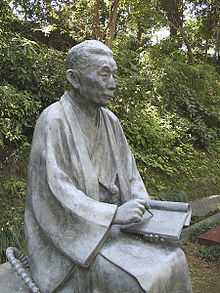Murō Saisei
| Murō Saisei | |
|---|---|
 Statue of Saisei, Kanazawa | |
| Born |
1 August 1889 Kanazawa, Ishikawa, Japan |
| Died | 26 March 1962 (aged 72) |
| Occupation | Writer |
| Genre | poetry, novel |
Murō Saisei (室生 犀星, 1 August 1889 - 26 March 1962) was a famous poet and novelist in modern Japanese literature from Kanazawa, Ishikawa Prefecture.
Early life
His real name was Murō Terumichi. Born in 1889, he was given birth by his mother Haru, who was never formally married to his father, Kobata Yozaemon-kichidane, a low-ranked military commander from the Kobata family. Right after his birth, he was adopted by Akai Hatsu, a common-law wife of Muro Shinjo, the chief priest at Uho Temple (真言宗寺院雨宝院). He gained his Muro family name at the age of seven when he was formally adopted by his stepfather. He never met his biological parents. The fact that he was born as an illegitimate child has had immense impact on his life and his literature. During his childhood, he was bullied by peers as 'the mistress' child'. At the same time, he craved for a mother he never had. This gave him the burden of having double bind thoughts to his biological mother, such as in the following poem;
Born into the womb of a HIPPU (匹婦:a woman in a very low social position who is considered stupid and worthless) on a summer's day.
This poem was written in 1943 when he was 54 years old - an example of how he was haunted by his childhood for most of his life.
Literary career
In 1902, he left Kanazawa High Elementary school (equivalent to junior high school today) and started working as a clerk at the Kanazawa Regional Court. His bosses included Haiku-readers such as Kawagoe Bukotsu (河越風骨) and Akakura Kinpu (赤倉錦風) who taught him how to read/compose haiku. After numerous applications to local newspapers, his haiku was first published on October 8, 1904 in Kitakuni-Shimbun. この時の号は照文。 Eventually, he also started writing poems and tanka (a Japanese poem of thirty‐one syllables).
He started to use his pen name - Saisei - in 1906. The name was an attempt to compete against Kokubu Saito, an active kanshi(Chinese-poetry) writer in the Kanazawa area at the time. He choose "Saisei" to mean "West of the Sai-River" which was the place he grew up. The Uho Temple was located on the left side of the River Sai. Saisei adored the atmosphere of this river and the mountainous sceneries up the river.
In 1913, he was invited by Kitahara Hakushu to write for Hakushu’s poem collection “Zanboa”. He befriended Hagiwara Sakutaro through this occasion. In 1916, Saisei and Sakutaro started an unofficial magazine called “Kanjo” (emotions) to publish their work. They continued to publish the magazine until their 32nd issue in 1919. During the same year, Saisei had written for Chūōkōron, a renowned literary magazine in Japan. He had published such literature as “Childhood” and “Awakening to Sexuality” and was gaining publicity as a writer. He published his first Haiku Collection “Gyomindouhatsu-kushu” (『魚眠洞発句集』) in 1929.
By the 1930s, he entered his era of writing novels and published a book titled “Goodbye Poem, I am breaking up with you” in 1934 as his declaration of farewell to poetry, but he actually had composed quite a lot of poems even after this public announcement. In 1935, he received the Bungei Konwakai (Discussion Group) Award with his novel “Ani Imouto” (Big Brother and Little Sister). He became part of the committee on the Akutagawa Prize (one of the most prestigious literature award in Japan) and continued until 1942. He also received the Kan Kikuchi Award in 1941.
Later years
It was after World War II that Saisei established his status as a novelist, producing many excellent novels. "Anzukko"(Apricot-girl) released in 1958 was a partial autobiography based on his daughter Asako. He won the Yomiuri Prize for this piece. Also in 1958, he received the Mainichi Publishing Culture Prize for his review "The biography of my beloved poet". For his classic based novel "Remenants from the Mayfly's diary" (1959), he received the Noma Literary Prize. In the following year, he created the 'Muro Saisei Poet Prize' from the money he received from the prize. He died of cancer in 1962.
Legacy
The full collection of his literature was published both before (by publisher Hibonkaku, 1936–37, 13 Volumes plus 1 attachment) and after (by publisher Shinchosha, 1964–68, 12 Volumes plus 2 attachments) his death . For his poetry, two publishers (Chikuma Shobo, Fuyukisha) have published full collection of poems. As for his novels, his daughter Asako Muro has edited and published "The Full Kingdom Story of Muro Saisei" (Sakuhinsha).
His most famous poem is the following from his small poetry collection:
Home is where you reminisce when you are far away
and sing with sorrow
He has never returned to his hometown Kanazawa after his success in Tokyo but always kept a picture of the River Sai.
A monument honoring Shusei Tokuda was erected near the summit of Mount Utatsu in 1947. The monument features writing authored by Saisei and was designed by architect Yoshirō Taniguchi.